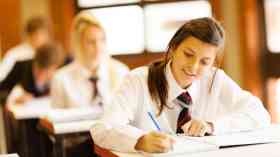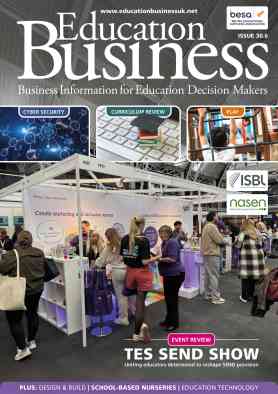Maths, ICT and industry: why back to basics is not enough

Technology plays a crucial and encompassing role in our lives, one that increases year on year. The technological revolution is in full swing and no one would deny the impact that it has on our lives, both work and leisure. What isn’t as widely acknowledged is that mathematics underpins this technology; the iPad, the PSP, the jet engine – you name it and maths played a role in its creation.
With the rate of technological development and the ever-increasing focus on employability, there is a recognised case for encouraging strong mathematical skills; as the subject forms the foundation of much of this century’s innovations, a workforce skilled in mathematics, along with the other STEM-subjects, is a crucial way of ensuring that a nation can sustain itself.
THE WORLD OUTSIDE THE CLASSROOM
If the main aim of educators is to help pupils attain knowledge and prepare themselves for the world outside the classroom then technology and learning are as inextricably linked as technology and business. It makes perfect sense to ready young people for industry by using tools which help develop the skills and knowledge that will be called upon in the workplace.
This is where ICT comes in. Some subjects, such as maths, benefit hugely from technology simply because of the springboard it provides to help them achieve a greater level of understanding. Teachers like me who advocate the use of ICT in maths lessons are not arguing against the need for the basics of a subject. The basics are the foundation for future understanding but knowledge of the practical application of the subject and a relational understanding of the different mathematical concepts is what is really needed. For this, ICT can be incredibly useful, helping improve the relational understanding of the subject by offering multiple mathematical representations that demonstrate how different mathematical concepts link together.
Understanding the different topics in maths lessons is important, but without teaching pupils how these topics link, to each other and to the world around them, we can’t expect them to understand or appreciate the big picture of how the subject really works.
TO MAKE TECHNOLOGY WORK FOR US
It is sometimes claimed that using technology in any way in lessons is beneficial for pupils belonging to the digital generation. This perspective is overly simplistic and misses the crucial idea that it should never be about the use of technology, but instead about the appropriate use of technology.
To that end it is essential that the equipment we use should befit the purpose and, although a laptop or an iPod Touch certainly have their uses, the subject of maths calls for more specialised equipment, such as handheld learning devices like the TI-Nspire.
The crux of the issue is that specialised equipment often requires specialised training. A lack of comfort and familiarity is often the main cause of resistence to regular use of ICT from professionals. This is where continued professional development is crucial for teachers, a fact recognised by the National Union of Teachers, who are behind the movement for increased teacher ICT training. In 2008, the union stated that it is imperative that school support staff are “provided with more support to help them get to grips with using the wide range of technology now available.”
OVERCOMING BARRIERS
There are barriers to regular CPD in teaching; hectic schedules, no ring-fenced funding and a lack of funds for supply cover are often the biggest hurdles. No formal continuous professional development requirement for teachers in England and Wales, coupled with budgetary constraints, means that this picture could be set to continue but there are other ways for teachers to obtain professional development that are flexible, or cost-effective enough to fit in with the primary aims of their schools.
The first and most basic of these is peer training and sharing of best-practice on an in-house or an informal local basis (e.g. TeachMeets – www.teachmeet.org.uk). Often, there may be the odd tech-savvy teacher who can lead the way; internal workshops or taking videos of how this teacher uses technology in his or her lesson to show other members of staff can offer a step in the right direction. Similarly, suppliers such as Texas Instruments offer free product training and will visit teachers on-site to outline ways to get the most out of the resources. Instruction for one teacher, followed by peer training can help to overcome the obstacle of lack of funding.
Aside from training courses offered by the TDA, the cost of which may be prohibitive in times of funding cuts and coalition claw-backs, there are organisations offering targeted CPD at no cost to the school or the teacher. The international ‘T3’ (Teachers Teaching with Technology), focuses on maths and science with free nationwide workshops. The organisations can arrange a free inset session on-site and will work with the school beforehand to ensure the session meets the specific objectives of the teachers involved.
In addition to training days, there are numerous online resources such as training videos or podcasts, lesson plans and activities to lighten the administrative load for teachers. The Teacher’s TV website is a useful source of video tutorials and online resource banks such as Nspiring Learning which gives step-by-step instructions, as well as teacher-created lesson plans, to engage learners with different mathematical topics. The BBC’s education site also offers helpful information for teachers – and for learners – and Cambridge University’s ‘Plus’ e-magazine is a mathematics teacher’s paradise.
SUBJECT ASSOCIATIONS PLAY A ROLE
Professional organisations play an important part in professional development in teaching. There are numerous subject associations for maths and many will feature ‘how to’ guides in journals and publications, along with events around the UK for teachers. Perhaps the most influential event for subject-leaders is the British Congress of Mathematical Education (BCME), which is timed to occur every four years between its international counterpart ICME. There is a cost for attending such events but the sheer number of professional development opportunities, best-practice guidance, peer to peer training and opportunity to exchange ideas will certainly justify the cost of attendance.
Ultimately, encouraging teachers to embrace technology and undertake regular professional development is a responsibility which lays with school leadership teams. What the profession needs is an easier route to CPD; one that does not add to the administrative burden that the profession endures. The job of teaching is a rewarding, challenging and ever-changing one. Support for those on the chalk-face must come from the top down, otherwise the lofty principles behind curriculum changes and new initiatives will fail to meet the needs of pupils and industry. JFK was once quoted as saying “Our progress as a nation can be no swifter than our progress in education. The human mind is our fundamental resource.” While reducing the deficit is important, it should not come at the cost of investment into the future of younger generations.
CPD sources and associations
• The National Centre for Excellence in Teaching Mathematics (www.ncetm.org.uk)
• T3 – teachers teaching teachers to provide professional development for the appropriate use of educational technology in the teaching and learning of mathematics and science (www.tcubed.org.uk)
• The Training and Development Agency CPD database (www.cpdsearch.tda.gov.uk).
• Learning and Skills Improvement Service (LSIS) STEM Programme (www.excellencegateway.org.uk)
• The Mathematical Association
(www.m-a.org.uk)
• Association of Teachers of Mathematics (www.atm.org.uk)
• Association of Mathematics Education Teachers (www.ametonline.org.uk/)
• National Association of Mathematics Advisers (www.nama.org.uk/)
• Mathematics in Education and Industry (www.mei.org.uk)
• Plus Magazine (www.plus.maths.org/)
• Nspiring Learning (www.nspiringlearning.org.uk)
Latest News
19/12/2025 - 09:54
The Education Committee has expanded its ongoing inquiry into the early years sector to examine how safeguarding can be strengthened in early years settings.
18/12/2025 - 09:25
The UK will be rejoining the Erasmus programme in 2027, following a package of agreements with the EU.
17/12/2025 - 09:31
Ofqual has fined exam board Pearson more than £2 million in total for serious breaches in three separate cases between 2019 and 2023 which collectively affected tens of thousands of students.
16/12/2025 - 09:19
The average funding rates will increase by 4.3% for under 2s, and by almost 5% for 3-and-4-year-olds.
15/12/2025 - 10:30
Local colleges are set to receive £570 million in government funding to expand training facilities in areas such as construction and engineering.







